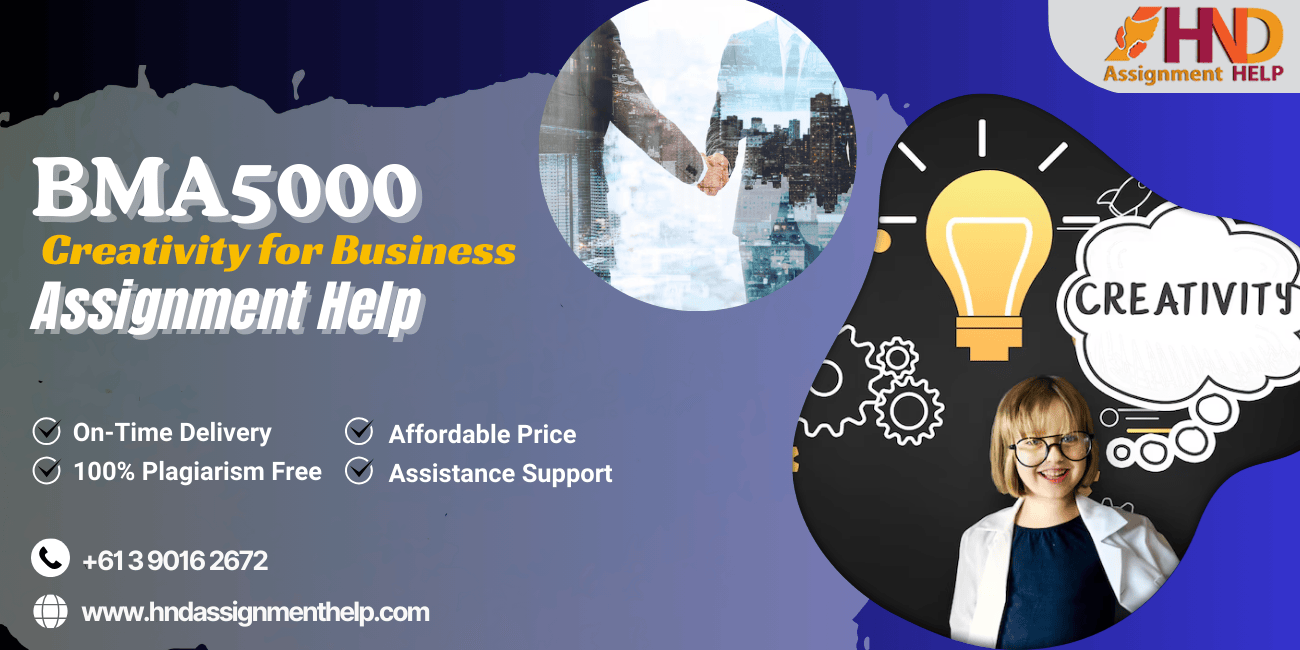Assignment help

Join our 150К of happy users
Get original papers written according to your instructions and save time for what matters most.


BMA5000 Creativity for Business Assignment Help
BMA5000 Creativity for Business Assignment Help
| Module Code: | BMA5000 |
| Module Title: | Creativity for Business |
| Assignment: | S2. Individual Report (60%) |
| Word Count: | 3000 words (+/- 10%) |
| Referencing Convention: | Harvard Referencing |
| Submit via: | Turnitin on VLE |
| Submission Deadline: | 28th May 2025, at 23:59 pm |
| Module Leader: |
| Assessment Brief 2 |
Introduction and Rationale
This assessment provides you with an opportunity to demonstrate your understanding of what creativity is and why it is important for organisations. It also allows you to show that you can conduct an interview, analyse and report on the data, and use this data to inform your arguments for why creativity is important in the workplace.
The purpose of your report is to explain what creativity is, and why creativity is important to organisations. That is, why should organisations try to be creative and encourage creativity within their employees? What benefits would this bring to the organisation?
Assessment Guidance
Your report should cover the following:
A brief summary of the report.
Introduce the topic and why it is important. That is, why the reader should be interested in reading the rest of the report. ‘Set the scene’ and provide contextual and background information.
Explain to the reader what creativity is. Provide a referenced definition. You may want to discuss how this definition is the same as, or different to, some of the many other definitions of creativity.
This will be one of the biggest sections of your report, if not the biggest section. You are welcome to use subheadings within this section. Use this section to discuss some of the reasons why creativity is important for organisations (e.g. because it enables them to create new products/services). You do not have to discuss all the reasons why creativity is important: it is better to discuss fewer topics in more depth than discuss many topics with very little or no detail. Use good quality sources to reference your arguments (compare and contrast different viewpoints from authors, theories and real-world examples).
Method (how you collected the data). You are expected to interview one person about creativity in the organisation they work in. This could include asking them about what creativity means to them, and why they think creativity is or is not important to their organisation. You could also ask for examples of creativity within their organisation. You can interview anyone who is working.
Identify and explain the method of data analysis - Results ( analyse your data and explain what the data revealed, connecting your findings from data to theories, providing adequate examples to interpret the data collected) Present evidence that support your argument from transcript in the appendices.
Remind the reader of the key points you made in your report. The conclusion for a report of this length would usually be approximately half a page.
Follow Bath Spa’s referencing guidelines for your reference list. Pay particular attention to using only good quality sources.
Appendix 1 – Interview script Appendix 2 – Informed interview consent form Appendix 3 – Interview plan Appendix 4 – Ethics form
Your Interview
It is recommended that you record your interview, transcribe it, and then use thematic analysis to analyse the data. You must ask your interviewee to provide their informed consent to be interviewed, and you should mention that you have done this in the Method subsection of your report. Please remain professional at all times when conducting the interview.
Interview question examples: Q1. Why do you think creativity is important to an organisation? Q2. How does your organisation encourage creativity? Q3. How has creativity benefitted yourself and colleagues? Any examples you can think of i.e. risk and collaboration? Q4. What benefits or detriment examples can you think of creativity brings to the workplace?
Notes
Your report will be capped at 40% if you submit it after the deadline, unless you have an extension. Extensions are granted only in the case of documented illness or other serious problems. Such extensions must be obtained before the submission date from Module Leader, and the work must be submitted by the agreed extension date. Work submitted up to one week late without an agreed extension will receive a maximum mark of 40%. Any coursework submitted more than one week late will not be marked and will receive a zero grade. |
| For all policies regarding the submission of your work please refer to the Programme and Student Handbooks available on VLE. |
Reading
The core text for this module is:
- Sawyer, R. (2012), Explaining Creativity: The Science of Human Innovation. Oxford: OUP.
Other reading:
- Brown, T. (2009), Change by Design: How Design Thinking Transforms Organisations and Inspires Innovation. New York: Harper Collins.
- Greetham, B. (2016), Smart Thinking: How to Think Conceptually, Design Solutions and Make Decisions. Palgrave: London.
- Saunders, M.N.K., Lewis P. & Thornhill, A. (2022), Research methods for business students, (8th edition). Pearson.
Assessment 2 Grading Criteria: Individual Report
| Criterion | Failed attempt 0-39% | Satisfactory attempt 40-49% | Sound attempt 50-59% | Good attempt 60-69% | Excellent attempt 70-84% | Outstanding attempt 85-100% |
Understanding 20% | Doesn’t answer question; Very limited; Highly descriptive; little, if any, analysis. | General knowledge demonstrated but mainly descriptive. | Some evidence of evaluative thought. | Developed analysis; Evidence of some reading beyond the core topics. | Evidence of thorough understanding; Good level of evaluation; Evidence of a good amount of reading beyond the core topics. | Full understanding; Critical throughout; Original argument; Evidence of extensive reading beyond the core topics. |
Depth of knowledge 25% | Inappropriate resources used; All key literature missing. | Sparse range of resources used; Resources mainly poor quality. | Appropriate range of reading evident; Mixed quality of resources; Limited use of resources. | Resources mainly of high quality: Resources well used. | Awareness of wider issues; Comprehensive range of resources used, all of high quality; Some evidence of critical engagement. | Extensive range; Insightful; Consistency critical engagement of resources. |
Structure 15% | Disorganised; unclear; entirely lacking structure. Loose ends. Unacceptably brief. | Satisfactory structure but some sections unclear. | Coherent; Clear throughout. | Logical throughout; Well organised; Well developed. | Integrated. Verry well structured and focused. Clear and fluid style. | Outstanding structure. Entirely focussed. Compelling arguments made throughout. |
General requirements
English 15% | Much incomprehensible. | Comprehensible. Written in third person. | Minimal grammatical, spelling & syntax errors. Proper paragraphs. Some structure. | No errors. Concisely written. Structure evident throughout. | Varied, engaging prose. Structure evident to sentence-level & substantially aids clarity. | Immaculate prose of publishable quality. |
Presentation 15% | Messy, gaudy presentation, and/or a lack of colour where this is required for clarity. | Generally consistent styling with some errors. | Good use made of headings. Consistency applied to headers/ footers, etc. | Several ‘levels’ of heading using with clearly defined styles. | ‘Clean’, professional, consistent styling. | Immaculate presentation akin to large corporates’ quality. |
Referencing 10% | Neither in-text or post-script list of references correct (in convention used and/or format). | Either in-text or post-script list of references correct. References are traceable. | Both forms substantially correct; List of references alphabetised. | Referencing wholly correct; Multiple papers from single year dealt with correctly. | Referencing doesn’t interfere with flow of prose. | Immaculate referencing. |
Qualities for sound, good, excellent, and outstanding classifications include all lower classification qualities.
Looking for expert assistance with your assignments? Get high-quality, plagiarism-free support from our Punjab Assignment Help service and boost your grades with ease!
Send Your assignment brief
Share your assignment brief and after Checking assignment requirement expert Will share the quote
Get Quote and pay
Once quote is sent, you can make Payment through secure option after which our team will start work
Get Assignment
Our team will Deliver the work you can share If any feedback

